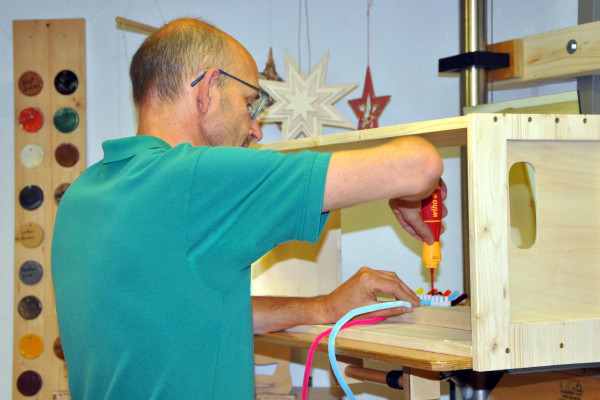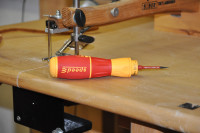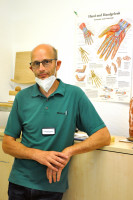Would you expect to find an e-screwdriver in the equipment of an occupational therapist?
Yet this is precisely the case with Johannes Schwär, an occupational therapist from the MEDICLIN Schlüsselbad Klinik in Bad Peterstal-Griesbach, Germany, who considers it to offer an ergonomic advantage for the electrician sector. When it comes to health prevention, employee motivation AND economic success, it is important for craftspeople to deliberately seek and use the ergonomic measures and solutions that are available nowadays – with a clear advantage for all involved. Now let's start at the beginning of the ergonomic challenges facing craftspeople and the role an e-screwdriver plays in the therapeutic workshop of the occupational therapist for physical rehabilitation in Germany's Black Forest region...
Ergonomic considerations are also gaining in importance in the electrician sector. The demand, by the users themselves, as well as their supervisors, managers and even insurance providers is getting louder and more persistent. Continuously full order books with the associated high workload and stress levels have long since become standard. Work time lost due to illness or lowered performance are expensive and must be avoided at all cost. Keeping up with the positive development of the market with a high-performance team requires an increased focus on prevention and subsequently ergonomics... So far so good in theory. However, how can ergonomic workplace design and principles be applied in practice in the electrician sector? Legitimate doubts, which Mr Schwär, who was originally trained as a painter and varnisher, can understand.
The trade and crafts sector is still in the early stages
“For stationary work places such as offices or the industry there are already many approaches, solutions and products. The work environment, equipment and the individual work stations can be optimally adjusted to the individual´s physical situation”, explains occupational therapist Schwär, adding that there are many options for preventing strain to the muscles, joints and tendons.
However, for work such as that performed by electricians, mechanics or service technicians, whose jobs by nature involve physical strain, it is far more difficult. According to Johannes Schwär, the reason for this are the typical conditions of the trade: “Just think about the distances covered by foot, the tool transport, working in unnatural positions, above the head or while kneeling. In addition, most of the work is mobile, involving different locations, construction sites and spatial conditions. Under such conditions, neither the work environment nor the work position can be influenced. The only thing that can be changed are the means of work and transport – and this is exactly where solutions should be sought”.
However, to arrive at the correct approaches and solutions, the problem or the cause should be understood first. Mr Schwär explains: "In general, strain is not a bad thing for the body, it is even important and beneficial under certain circumstances, when it consists of alternating and controllable strain and movement sequences. On the other hand, static activities, constantly recurring movement patterns, remaining too long in a single position, unilateral use of force, for example when carrying heavy tool cases, are fatal in the long run. These constant faulty stimuli of the same muscle or tendon areas result in a variety of conditions and illnesses in the entire musculoskeletal system”.
An ergonomic alternative – e-screwdrivers
He used the example of an e-screwdriver to explain the potential he can see in using modern, ergonomic hand tool solutions. Mr Schwär considers the speedE® from Wiha to be a true means of relief during fastening tasks, for which there was previously no alternative. To him the reasons have quite obviously to do with the hands – “In their job, electricians often have to perform an extremely high number of manual fastenings. All fastening and rotation movements proceed according to the same movement pattern, the stimuli to the muscle/skeleton system are repeated many times. Often, this is exacerbated by an uncomfortable working position, which makes the fastening process additionally harmful by the faulty strain. Whether above the head, on the floor, in difficult to reach areas, in areas that are poorly illuminated or that have poor or no air conditioning, the technician has to work with great sensitivity and never abating concentration. These factors make extensive fastenings power and time consuming activities that one wants to get over with as soon as possible”.
Unfortunately, battery-operated screwdrivers with higher power transmission cannot be used due to the necessary material protection during sensitive fastenings and the required voltage safety of up to 1000 V AC
The occupational therapist discovered the speedE® II during his search for new possibilities and solutions for ergonomic consulting in the trade and crafts sector. “I was immediately convinced by its concept: The users are spared the constant rotation of the wrist as the e-screwdriver handles the tedious fasting automatically and 3 times as fast as fastening by hand. This reduces both the required force and time. Fastening above the head or while kneeling is carried out faster and more conveniently. The work position can be changed quickly and the effort can be saved for other activities.
In addition, a ring LED optimally illuminates the position of the screws. Material protection is ensured by two easily adjustable material protection levels of 0.4 and 1.0 Nm. What is more, the e-screwdriver in combination with a large number of insulated slimBits offers 100% voltage protection up to 1000 V AC.
Sensation leads to comprehension
To practically demonstrate to his patients how big a difference the use of ergonomic tools makes, the therapist employs some very creative ideas. He even builds devices and appliances that he designs himself for the therapeutic workshop to simulate work situations. “Only when the patients feel, experience and sense how much easier and convenient working with the appropriate tool, equipment or device is, does the aha effect set in. It is often surprising to them how such little change can have such a great effect. This is precisely when the journey starts for them. Each one of them is partially responsible for their own health at their place of work. There are many adjustments and possibilities of utilising ergonomics if one looks out and seizes the opportunities”, said Mr Schwär.
Ergonomics offers advantages to everyone involved
He also considers the employers and managers to be equally responsible. According to the committed therapist, any investment in ergonomics and the verification of the individual wishes of the employees in this regard are also economically advantageous. “If, for example, by using the proper chair or the proper tool only a few days of absence due to musculoskeletal illness can be prevented or if using proper equipment improves the motivation of the employees, the investment already pays off. Not to mention the positive effect on the employees when their concerns are taken seriously and they enjoy working more”, Schwär says with conviction.
Constantly in search of improvements, ideas and approaches for his patients from the trade and craft sector, Mr Schwär will continue looking for new concepts and possibilities and finally has to admit: “In this area we have not advanced as far as in the office or industrial sector. Yet I am driven daily by the ambition and the conviction that with many, often small, changes, the daily work in the field can be changed – a never ceasing process".
For more information about the e-screwdriver visit www.wiha.com/speede2.























